p.435
p.440
p.445
p.450
p.458
p.465
p.469
p.474
p.479
The Timber Supply Chain Risks Assessment Based on Weighing with Rough Set and Fuzzy Comprehensive Assessment
Abstract:
This paper studied the timber supply chain risks assessment. Firstly we established the risks assessment index system according to the characteristics of timber supply chain, and then we formulated the method of weighing indexes based on rough set theory, and then we established the supply chain risks assessment models with fuzzy comprehensive theory to judge the risks level. By case analysis, we draw the conclusion that the factors of production and processing and the factors of sales make grater impact on the timber supply chain, while the factors of natural and the factors of reverse recycling make smaller impact, and the risks of other factors are moderate.
Info:
Periodical:
Pages:
458-464
Citation:
Online since:
March 2011
Authors:
Price:
Сopyright:
© 2011 Trans Tech Publications Ltd. All Rights Reserved
Share:
Citation:


